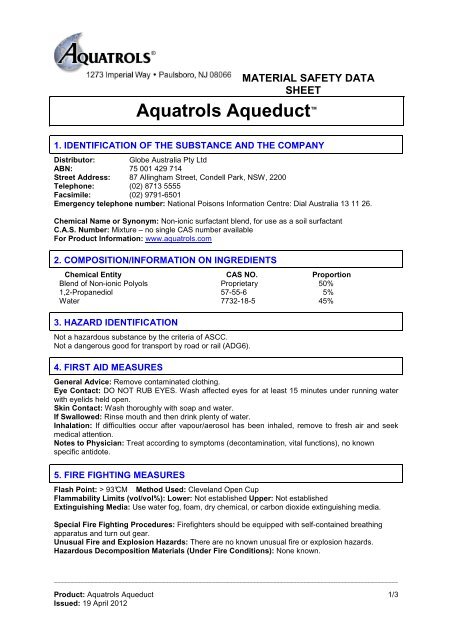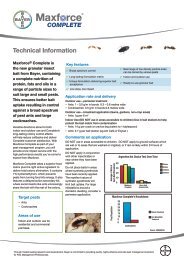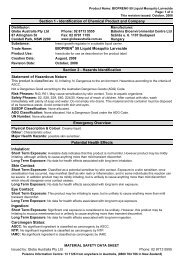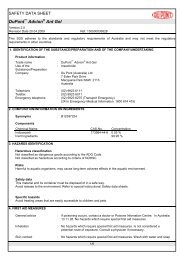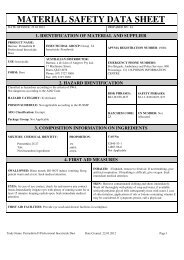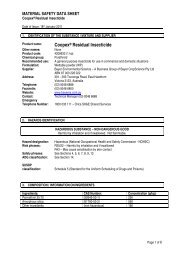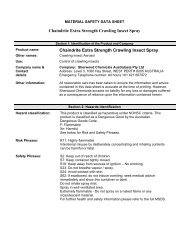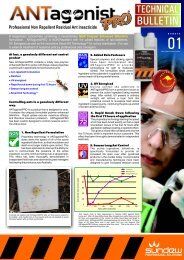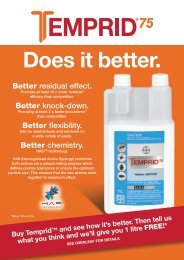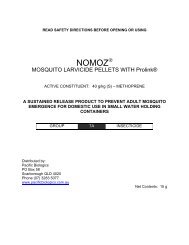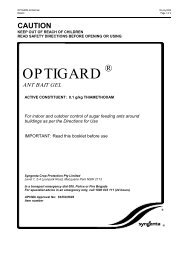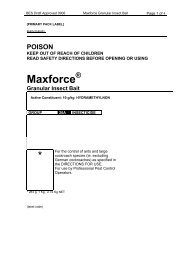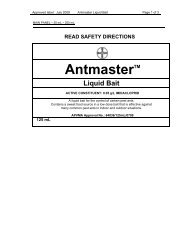Aquatrols Aqueduct - MSDS - 19-04-2012 - Globe Australia
Aquatrols Aqueduct - MSDS - 19-04-2012 - Globe Australia
Aquatrols Aqueduct - MSDS - 19-04-2012 - Globe Australia
Create successful ePaper yourself
Turn your PDF publications into a flip-book with our unique Google optimized e-Paper software.
MATERIAL SAFETY DATA<br />
SHEET<br />
<strong>Aquatrols</strong> <strong>Aqueduct</strong> <br />
1. IDENTIFICATION OF THE SUBSTANCE AND THE COMPANY<br />
Distributor: <strong>Globe</strong> <strong>Australia</strong> Pty Ltd<br />
ABN: 75 001 429 714<br />
Street Address: 87 Allingham Street, Condell Park, NSW, 2200<br />
Telephone: (02) 8713 5555<br />
Facsimile: (02) 9791-6501<br />
Emergency telephone number: National Poisons Information Centre: Dial <strong>Australia</strong> 13 11 26.<br />
Chemical Name or Synonym: Non-ionic surfactant blend, for use as a soil surfactant<br />
C.A.S. Number: Mixture – no single CAS number available<br />
For Product Information: www.aquatrols.com<br />
2. COMPOSITION/INFORMATION ON INGREDIENTS<br />
Chemical Entity CAS NO. Proportion<br />
Blend of Non-ionic Polyols Proprietary 50%<br />
1,2-Propanediol 57-55-6 5%<br />
Water 7732-18-5 45%<br />
3. HAZARD IDENTIFICATION<br />
Not a hazardous substance by the criteria of ASCC.<br />
Not a dangerous good for transport by road or rail (ADG6).<br />
4. FIRST AID MEASURES<br />
General Advice: Remove contaminated clothing.<br />
Eye Contact: DO NOT RUB EYES. Wash affected eyes for at least 15 minutes under running water<br />
with eyelids held open.<br />
Skin Contact: Wash thoroughly with soap and water.<br />
If Swallowed: Rinse mouth and then drink plenty of water.<br />
Inhalation: If difficulties occur after vapour/aerosol has been inhaled, remove to fresh air and seek<br />
medical attention.<br />
Notes to Physician: Treat according to symptoms (decontamination, vital functions), no known<br />
specific antidote.<br />
5. FIRE FIGHTING MEASURES<br />
Flash Point: > 93°CM Method Used: Cleveland Open Cup<br />
Flammability Limits (vol/vol%): Lower: Not established Upper: Not established<br />
Extinguishing Media: Use water fog, foam, dry chemical, or carbon dioxide extinguishing media.<br />
Special Fire Fighting Procedures: Firefighters should be equipped with self-contained breathing<br />
apparatus and turn out gear.<br />
Unusual Fire and Explosion Hazards: There are no known unusual fire or explosion hazards.<br />
Hazardous Decomposition Materials (Under Fire Conditions): None known.<br />
______________________________________________________________________________________________________<br />
Product: <strong>Aquatrols</strong> <strong>Aqueduct</strong> 1/3<br />
Issued: <strong>19</strong> April <strong>2012</strong>
6. ACCIDENTAL RELEASE MEASURES<br />
MATERIAL SAFETY DATA SHEET<br />
Evacuation Procedures and Safety: Wear appropriate respiratory protection and protective gear for<br />
the situation and provide adequate ventilation during clean up. See Personal Protection information in<br />
Section 8.<br />
Containment of Spill: Follow procedures described below.<br />
Cleanup and Disposal of Spill: Absorb with an inert absorbent. Sweep up and place in an<br />
appropriate closed container (see Section 7: Handling and Storage). Clean up residual material by<br />
washing area with water. Collect washings for disposal.<br />
Environmental and Regulatory Reporting: Do not flush to drain.<br />
7. HANDLING AND STORAGE<br />
No special storage and transport requirements. This product has no UN classification. Not a<br />
Scheduled Poison. Containers should be kept closed in order to minimise contamination. Keep from<br />
extreme heat and open flames, and make sure that the product does not come into contact with<br />
substances listed under "Materials to avoid".<br />
8. EXPOSURE CONTROLS / PERSONAL PROTECTION<br />
Exposure Guidelines: No exposure limits were found for this product or any of its ingredients.<br />
Engineering Controls: When potential for exposure exists, provide adequate general area<br />
dilution/exhaust ventilation.<br />
Personal Protection: Avoid contact with eyes and skin. DO NOT inhale spray mist. When preparing<br />
spray wear PVC or rubber apron, elbow length PVC gloves and face shield. When using the prepared<br />
spray wear face shield. If product on skin, immediately wash area with soap and water. After use and<br />
before eating, drinking and smoking, wash hands, arms and face thoroughly with soap and water.<br />
After each day’s use, wash gloves, face-shield and contaminated clothing.<br />
Work Practice Controls: Personal hygiene is an important work practice exposure control measure<br />
and the following general measures should be taken when working with or handling this material.<br />
1. Do not store, use, and/or consume food, beverages, tobacco products, or cosmetics in area<br />
where this material is stored.<br />
2. Wash hands and face carefully before eating, drinking, using tobacco, applying cosmetics, or<br />
using the toilet.<br />
3. Wash exposed skin promptly to remove accidental splashes of contact with this material.<br />
9. PHYSICAL AND CHEMICAL PROPERTIES<br />
Physical and Chemical properties here represent typical properties of this product.<br />
Physical Appearance: Clear liquid<br />
Odour: Mild polyol<br />
pH (5%): 4.0-6.0<br />
Specific Gravity: 1.03 – 1.05 g/mL @ 25 o C<br />
Water Solubility: Soluble<br />
Freezing Point Range: Not established<br />
Vapor Pressure: Not established<br />
Vapor Density: (Air = 1) >1<br />
Percent Volatiles: Volume %: Not established Weight %: Not established<br />
Viscosity: Not established<br />
10. STABILITY AND REACTIVITY<br />
Chemical Stability: This material is stable under normal handing and storage conditions<br />
described in Section 7.<br />
Conditions to be Avoided: Keep away from heat and flames.<br />
Materials/Chemical to be Avoided: Strong oxidizing agents.<br />
______________________________________________________________________________________________________<br />
Product: <strong>Aquatrols</strong> <strong>Aqueduct</strong> 2/3<br />
Issued: <strong>19</strong> April, <strong>2012</strong>
MATERIAL SAFETY DATA SHEET<br />
The following Hazardous Decomposition Products might be Expected: Oxides of carbon and<br />
hydrogen.<br />
Hazardous Polymerization will not occur.<br />
Avoid the Following to Inhibit Hazardous Polymerization: No data available.<br />
11. TOXICOLOGICAL INFORMATION<br />
Acute Eye: Contact with eyes may result in temporary irritation.<br />
Acute Skin: Prolonged or repeated skin contact may result in slight, temporary irritation.<br />
Acute Inhalation: Inhalation of vapors or mists may result in respiratory irritation.<br />
Acute Ingestion: Ingestion of large amounts will result in diarrhea and weakness. LD50 (rat)<br />
10,200 mg/kg<br />
Chronic Effects: There are no known chronic effects associated with this material.<br />
12. ECOLOGICAL INFORMATION<br />
Ecotoxicity Information: No data available.<br />
Environmental Fate Information: No data available.<br />
Waste Disposal Method: See section 13.<br />
13. DISPOSAL CONSIDERATIONS<br />
In the event of a major spill, prevent spillage from entering drains or water courses. Evacuate the spill<br />
area and deny entry to unnecessary and unprotected personnel. Wear full protective clothing including<br />
face mask, face shield and gauntlets. All skin areas should be covered. Thoroughly launder protective<br />
clothing before storage or re-use. See above under Personal Protection regarding <strong>Australia</strong>n<br />
Standards relating to personal protective equipment.<br />
Stop leak if safe to do so, and contain spill. Absorb onto sand, vermiculite or other suitable absorbent<br />
material. Sweep up and shovel or collect recoverable product into labelled containers for recycling or<br />
salvage. Can be slippery on floors, especially when wet. After spills, wash area preventing runoff from<br />
entering drains. If a significant quantity of material enters drains, advise emergency services. Full<br />
details regarding disposal of used containers, spillage and unused material may be found on the label.<br />
If there is any conflict between this <strong>MSDS</strong> and the label, instructions on the label prevail. Dispose of<br />
only in accord with all regulations. Advise laundry of nature of contamination when sending<br />
contaminated clothing to laundry.<br />
14. STORAGE & TRANSPORT INFORMATION<br />
Road and Rail Transport- Marine Transport- Air Transport<br />
Not classified as Dangerous Goods by the criteria of the <strong>Australia</strong>n Dangerous Goods Code (ADG<br />
Code) for transport by Road and Rail, transport by Sea or transport by Air.<br />
15. REGULATORY INFORMATION<br />
Inventory Status: All ingredients are on the AICS inventory.<br />
16. OTHER INFORMATION<br />
All information contained in this document is as accurate as possible based on information submitted<br />
by raw material suppliers. <strong>Globe</strong> <strong>Australia</strong> Pty Ltd will not be responsible for any damages that may<br />
result from reliance on the information contained herein.<br />
Contact: John Illingworth Mobile <strong>04</strong>18 844 861<br />
SST <strong>Australia</strong> Pty Ltd Phone 03 9720 6306<br />
Unit 4 97 Bayfield Rd<br />
East Bayswater VIC 3153<br />
Please read all labels carefully before using product.<br />
______________________________________________________________________________________________________<br />
Product: <strong>Aquatrols</strong> <strong>Aqueduct</strong> 3/3<br />
Issued: <strong>19</strong> April, <strong>2012</strong>


